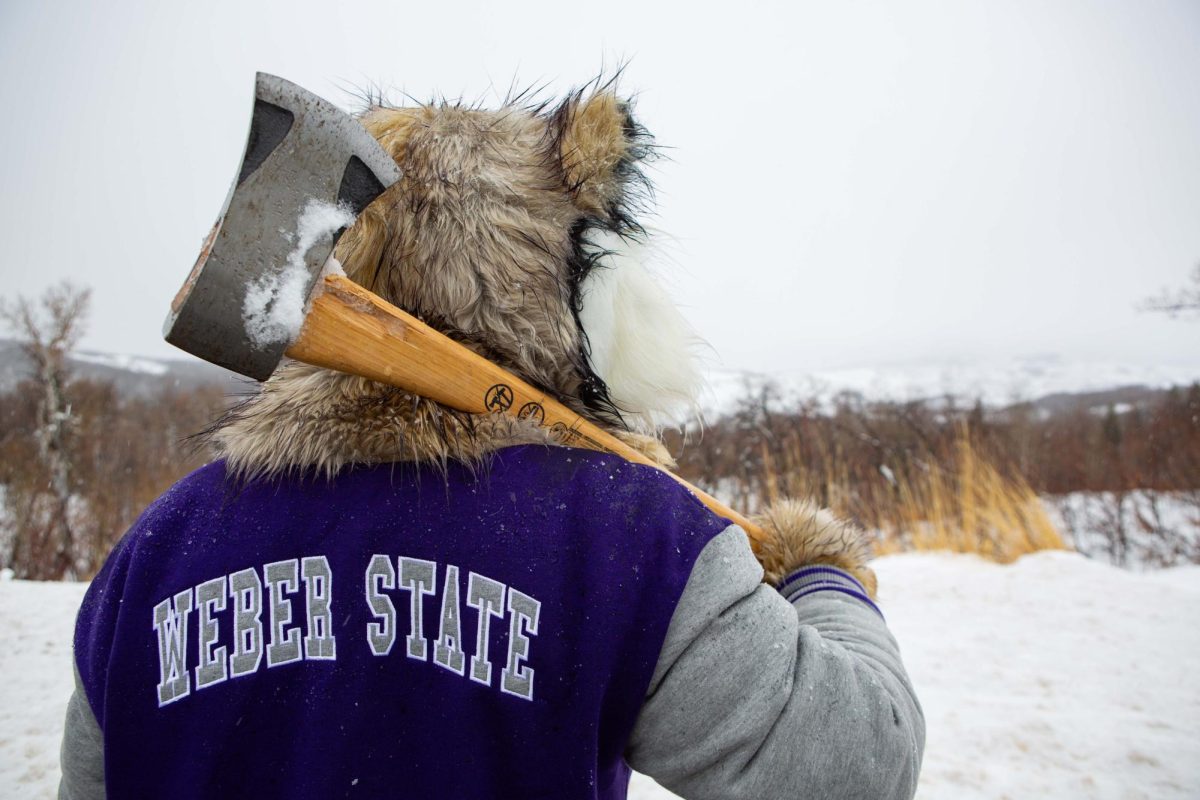After nearly three decades of work, three scientists in Tracy Hall celebrated the success of a passion project that began in the back of a movie theater.

“Everyone kept telling us it couldn’t be done,” Ian Malcolm, chaos-theorist and lead mathematician, said. “They told us it was fiction, and it would always remain fiction; we proved them all wrong today.”
The project started in Uptown Theater in Washington D.C. on June 9, 1993, where “Jurassic Park” premiered for the first time. The three scientists, Malcolm, paleontologist Alan Grant and paleobotanist Ellie Sattler, had met earlier at the annual Society of Vertebrate Paleontology conference at the Smithsonian where they were presenting their respective research.
From there, a conversation sparked between the three of them regarding the 1990 Michael Crichton novel, also named “Jurassic Park,” and the rest is ancient history — metaphorically.
“I had never met anyone who believed we could bring the science to science fiction like Ellie and Ian,” Grant said. “Most people looked at Crichton as if he had laid out the plans to National Treasure’s fictional city of gold, but we looked at it as if he had written the atlas to the very foundations of the world.”
After the conference concluded, the three realized they all had plans to attend the premiere of the newest science fiction film on the block, Spielberg’s adaptation of their private scientific fascinations. They walked into the premiere as scientists and walked out with plans to become scientific pioneers.
“I thought this little group would last a few months as we volleyed ideas back and forth,” Sattler said. “Then, like most great conference friends, it would fizzle out to the occasional courtesy call and research presentation attendance when we were in the neighborhood. Instead, we exchanged major papers, long landline calls — I’m sure racking up quite the phone bill, if it looked anything like mine — and infinite ideas.”
By 2000, the three had started to break down the process of what needed to be done to replicate the process of bringing dinosaurs to life like they had been on the silver screen. While the process Crichton used in his novel and adapted for film got them started, it wasn’t nearly detailed enough to replicate in real life.
The fictional process had many problems when applying it in the real world. The first problem arose in the amount of DNA extractable from these sources, which is nowhere near enough to sequence the full genome of a dinosaur.
To clone a dinosaur, a complete set of a dinosaur’s genome is necessary, and the trio theorized the Crichton was right — at least some of the DNA could be extracted by tapping into blood-sucking bugs trapped in amber, but it was unlikely that a fossil could be used to do the same.
Even after being lucky enough to be funded by a generous benefactor to get as many amber-encased bugs as possible, most of the bugs did not have nearly enough DNA in them to create a dinosaur. Luckily for the trio, a new test, called the polymerase chain reaction, was developed in 1983 and continued to become widely used after two biochemists were awarded the Nobel Prize for the breakthrough in 1993.
The PCR test allows scientists to copy a single and specific DNA sample rapidly. Grant, Sattler and Malcolm were able to use this method to exponentially amplify their limited samples to study the order of DNA subunits.
A number of issues arose in trying to communicate these results across the country, so the three decided to relocate to Weber State University in early 2002 after the institution received a large grant from the same generous donor, John Hammond, who was also funding the trio’s research into recreating the largest animals known to man.
Even with this newly-discovered technology that was rapidly becoming indispensable throughout the medical sciences, it took major computing power to reassemble the DNA into the correct order. Even with those hurdles tackled, they were still left with their biggest hurdle.
“The biggest problem came from the gaps that time left in the genetic material,” Grant said. “It’s impossible that something as old as a micropachycephalosaurus would have its entire genome survive both the fossilization process and the deterioration of time.”
This is where Crichton had once again led them to look down the right path. The scientific developments toward finding a dinosaur’s closest living relative would lead Weber State’s fossil-fascinated scientists to the crocodile. A University of California Santa Cruz team of scientists pieced together the shared ancestor that crocodiles, birds and dinosaurs shared, the group of which they would name “archosaurs.”
Knowing this, Sattler, Grant and Malcom theorized that by using the crocodile DNA to fill in the gaps of the dinosaur DNA, they would be able to create a fully-cloneable DNA strand that would be as close to the dinosaurs that walked the Earth 240 million years ago as possible.
This gave Grant the idea to synthesize the full string of DNA using a method of replication called oligonucleotide synthesis, which Malcolm was able to help modify. After over a decade of work, the Grant and Malcolm oligonucleotide synthesis process was born. This process allows for the creation of an entire chromosome, which to this point was impossible.
This process revolutionized the field of bioengineering, and the gene-editing technology known as CRISPR has even begun utilizing it in research to cure type 1 diabetes. The pair are the favorites for a Nobel Prize in 2023 for creating this new process.
At this point, these full chromosomes were bound to various proteins to become functional before being injected into several membranes that would make up the cell’s nucleus.
Once these chromosomes are created, the process can finally begin to create a fully functional dinosaur. The movie got it wrong here — implanting it in an egg wasn’t logical.
“We had no idea how large dinosaur embryos might get,” Sattler said. “It might be logical to use unfertilized crocodile eggs to help the growth of the dinosaur in the future, but for now, growing them in a synthetic environment is the best we can do.”
It took 5,464 attempts before a fertilized dinosaur grew to a viable maturity, but Tracy Hall is now home to the first velociraptor.
“The movies depict them much larger than they are,” Malcolm said. “At full maturity, a velociraptor is only going to be three to four feet long.”
The first raptor, named Blue by the team, is about six months old. The team reports she is thriving, and Hammond has purchased a small enclosure outside of Logan, Utah, to allow her the freedom to room once she reaches full maturity.
“We might have finally been successful with one dinosaur, but this is by no means the end of the journey,” Grant said. “We saw the flaws in monetizing these creatures, but we need to find out how much further we can go, how much further we should go. These beautiful creatures can be studied and used for incredible things, and we plan to do it.”
Despite the incredible discovery, not everyone is encouraged to see fiction become reality. Owen Grady, renowned animal behaviorist, is unsettled at this recent development.
“These are animals, and nature doesn’t like to be trifled with,” Grady said. “It’s one thing to bring back animals that humans are responsible for murdering into extinction, but we have never coexisted with them, and there is a reason for that.”
Grady was brought in during the late stages of embryonic development, but ultimately, he parted with the group over ethical disagreements.
“It’s amazing, it’s revolutionary, it’s beautiful and it’s beyond the most dangerous thing that’s ever been done,” he said. “I want to believe that this isn’t going to be humanity’s greatest scientific disaster, but I am not an optimist. I believe we will all live to regret seeing science pushed to the limits of fiction.”
Despite Grady’s pessimism, the trio will be welcoming several renowned scientists into their lab over the next months. The breakthrough has also brought much attention to Weber State’s doors. A four-year college mostly known for its teaching and nursing programs is suddenly home to the greatest scientific discovery of the last century, rivaled only by antibiotics.
“The university has been amazing to us,” Malcolm said. “They took a huge chance on us, and I’m glad they will reap some of the rewards of seeing this research to completion.”
Weber State will hold a press conference later this week discussing the project and a new grant that has been rumored to be available for certain students interested in getting involved with the new studies.







